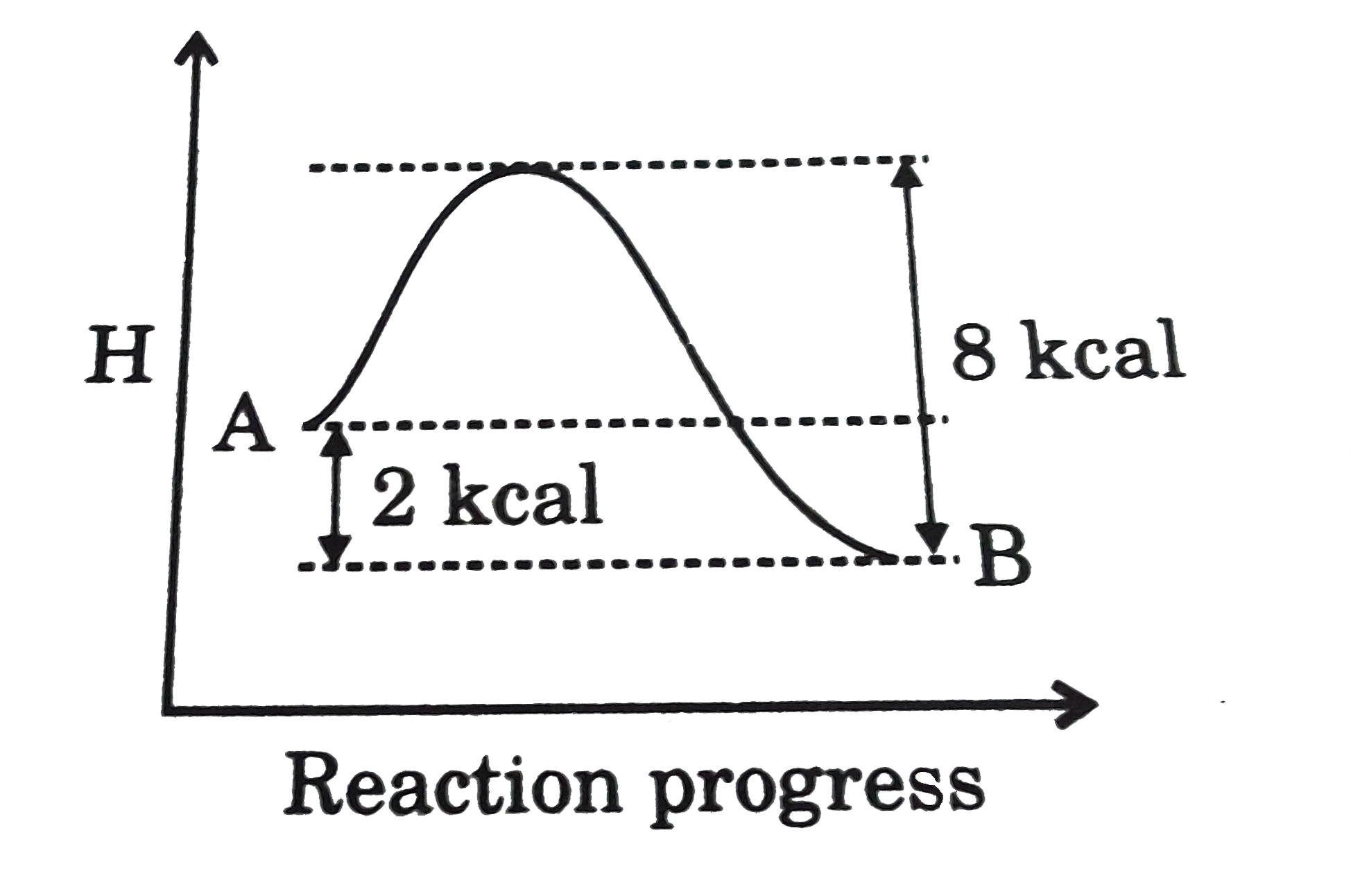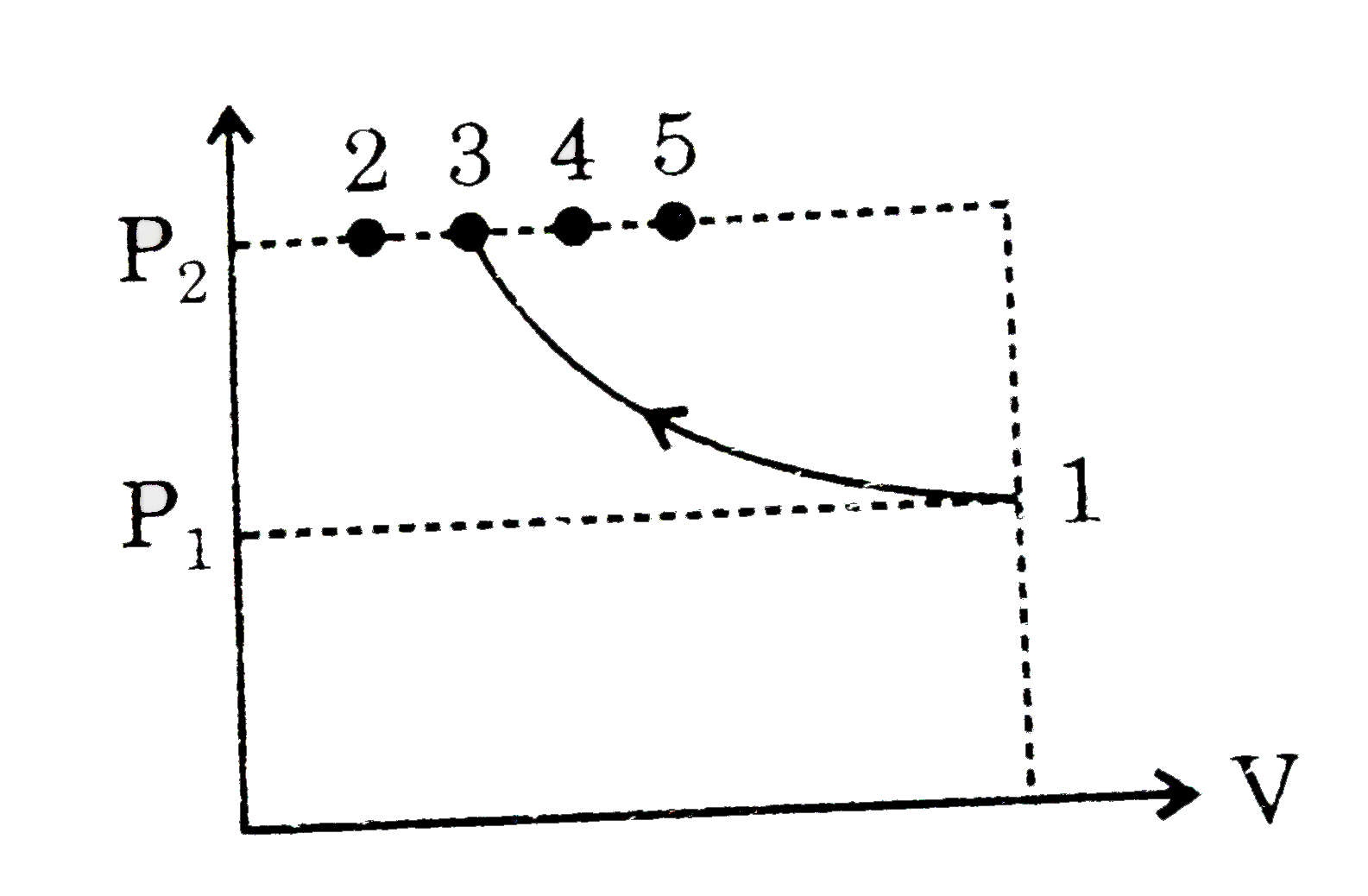For a reversible factors in forward and backward direction are assumed to be equl. Select the incorrect option (s) on the basis of above graph. [take R:=2Cal/mole−K]

(Ea)forward=6Kcal/mol
At 500K, fraction of molecules of A crossing energy barrier for backward reaction is e−8.
At 500 K, fraction of molecules of B crossing energy barrier for backward reaction is e−8.
Equilibrium constant for the reaction is e−2 at 500K temperature.
The correct Answer is:D
Step by step video, text & image solution for For a reversible factors in forward and backward direction are assumed to be equl. Select the incorrect option (s) on the basis of above graph. [take R : =2 Cal//"mole"-K] by Chemistry experts to help you in doubts & scoring excellent marks in Class 12 exams.
Updated on:21/07/2023Topper's Solved these Questions
- GRAPHICAL INTERPRETATIONBook:GRB PUBLICATIONChapter:GRAPHICAL INTERPRETATIONExercise:I.Electrochemistry
Explore 1 Video
- GRAPHICAL INTERPRETATIONBook:GRB PUBLICATIONChapter:GRAPHICAL INTERPRETATIONExercise:Electrochemistry
Explore 9 Videos
- GRAPHICAL INTERPRETATIONBook:GRB PUBLICATIONChapter:GRAPHICAL INTERPRETATIONExercise:H. Chemical Kinetics
Explore 1 Video
- F-BLOCK ELEMENTSBook:GRB PUBLICATIONChapter:F-BLOCK ELEMENTSExercise:Subjective type
Explore 7 Videos
- HYDROCARBON (ALIPHATIC)Book:GRB PUBLICATIONChapter:HYDROCARBON (ALIPHATIC)Exercise:Previous years jee questions
Explore 28 Videos
Similar Questions
A drunkard moves on a straight road such that he takes 7 steps forward and 2 steps backward in each cycle. If the stride length of each step is 1 feet and the drunkard moves with a speed 2 feet/s in forward direction and 4 feet/s in backward direction, then the time after which the drunkard will fall into a pit 11 feet further from his starting point is
View SolutionThe state of equilibrium is in a dynamic balance between forward and backward reaction. This balance can be disturbed by changing concentration, temperature or pressure. If done so a cartain net change occurs in the system. The direction of change can be predicted with the help of Le Chatelier principle. It states that when a system in equilibrium is disturbed by a change in concentration of temperature, a 'net' change occurs in it in a direction that tends to decrease the disturbing factor. Consider the following exothermic heterogenous equilibrium,
M2O(s)+2HNO3(aq)⇔2MNO3(aq)+H2O(l) withKC=3 at 300K. Select the incorrect option.
View Solution
Knowledge Check
0.01 mol TNT was completely decomposed as,
C7H5N3O6(s)−−→CO(g)+H2(g)+N2(g)+C(s) TNT
The gases evolved occupied 2.24 L at constant pressure and 273 K in the eudiometer . Select the correct option on the basis of above information.APartial pressure of CO is 0.6 atm in the evolved gasBIf just sufficient O2 si introduced in the container to combust CO and H2 completely, then final volume fo gases would be 0.68 L at 1 atm and 273 KCIf just sufficient O2 is introduced in the container to combust CO and H2 completely, then fianl volume of gases would be 0.896 L at 1 atm and 273 KDIf after combustion the mixture of gases at 273 K is passes through KOH(aq) , contraction of 1.344 L would take place5 moles gas are introduced in 1 litre container at 47∘C. Select the correct option(s).
[R=0.08litre-atm/mol-K]APressure would be 128 atm if it behaves ideallyBpressure would be 28 atm if it follows van der Waals' equation, a=4 atm-litre2/mol2 and b=0CPressure would be 33.33 atm if it follows van der Waals' equation , a=4 atm-litre2/mol2 and b=0.04L/moleDPressure would be 160 atm if it follows van der Waal's equation, a=0atm−litre2/mol2 and b=0.04L/moleAn ideal gas is taken from the same initial pressure P1 to the same final pressure P2 by four different process. If it is known that point 3 corresponds to a reversible adiabatic, point 4 corresponds to a single step adiabatic and point 2 corresponds to reversible isothermal. Select the incorrect option (s).
 APoint 5 may be achieved by two step adiabatic processBTemperature of the gas is more at point 3 than at point 4CTemperature of the gas is more at point 3 than at point 2DWork done in process "1-3" is more than work done in process "1-2".
APoint 5 may be achieved by two step adiabatic processBTemperature of the gas is more at point 3 than at point 4CTemperature of the gas is more at point 3 than at point 2DWork done in process "1-3" is more than work done in process "1-2".
The state of equilibrium is in a dynamic balance between forward and backward reaction. This balance can be disturbed by changing concentration, temperature or pressure. If done so a cartain net change occurs in the system. The direction of change can be predicted with the help of Le Chatelier principle. It states that when a system in equilibrium is disturbed by a change in concentration of temperature, a 'net' change occurs in it in a direction that tends to decrease the disturbing factor. For the equilibrium,
Fe3+(aq)(yellow)+SCN−(aq)⇔[Fe(SCN)2+](aq)(deep red)
Select the correct option.
View SolutionMass action ratio or reaction quotient Q for a reaction can be calculated using the law of mass actionl,
A(g)+B(g)⇔C(g)+D(g)
Q=[C][D][A][B]
The value of Q decides whether the reaction is at equilibrium or not.
At equilibrium, Q=K
For non-equilibrium process Q≠K
When Q>K, reaction will be favoured in backward direction and when Q<K, it will be favoured in forward direction. For the reaction : 2A+B⇔3C at 298 K, Kc=49 A 3 L vessel contains 2, 1 and 3 moles of A, B and C respectively. The reaction at the same temperature :
View SolutionFor a reaction, aA+bB⇔cC+dD, the reaction quotient Q=[C]c0[D]d0[A]a0[B]b0, where [A]0, [B]0, [C]0, [D]0 are initial concentrations. Also Kc=[C]c[D]d[A]a[B]b where [A], [B], [C], [D] are equilibrium concentrations. The reaction proceeds in forward direction if Q<Kc and in backward direction if Q>Kc. The variation of Kc with temperature is given by: 2303log(KC2)KC1=ΔHR[T2−T1T1T2].
For gaseous phase reactions Kp=Kc(RT)Δn where Δn= moles of gaseous products − moles of gaseous reactants. Also −ΔG∘=2.303RTlog10Kc.
Which relation is correct?
View SolutionFor a reaction, aA+bB⇔cC+dD, the reaction quotient Q=[C]c0[D]d0[A]a0[B]b0, where [A]0, [B]0, [C]0, [D]0 are initial concentrations. Also Kc=[C]c[D]d[A]a[B]b where [A], [B], [C], [D] are equilibrium concentrations. The reaction proceeds in forward direction if Q<Kc and in backward direction if Q>Kc. The variation of Kc with temperature is given by: 2303log(KC2)KC1=ΔHR[T2−T1T1T2].
For gaseous phase reactions Kp=Kc(RT)Δn where Δn= moles of gaseous products − moles of gaseous reactants. Also −ΔG∘=2.303RTlog10Kc.
The heat or reaction for an endothermic reaction, in equilibrium is 1200cal, at constant volume is more than at constant pressure at 300K. The ratio of Kp/Kc is:
View SolutionFor a reaction, aA+bB⇔cC+dD, the reaction quotient Q=[C]c0[D]d0[A]a0[B]b0, where [A]0, [B]0, [C]0, [D]0 are initial concentrations. Also Kc=[C]c[D]d[A]a[B]b where [A], [B], [C], [D] are equilibrium concentrations. The reaction proceeds in forward direction if Q<Kc and in backward direction if Q>Kc. The variation of Kc with temperature is given by: 2303log(KC2)KC1=ΔHR[T2−T1T1T2].
For gaseous phase reactions Kp=Kc(RT)Δn where Δn= moles of gaseous products − moles of gaseous reactants. Also −ΔG∘=2.303RTlog10Kc.
(B) The moisture content of a gas is often expressed as dew point, the temperature at which if gas is cooled becomes saturted with vapour pressure of water at that temperture. Dew point of H2O is 43∘C having vapour pressure 0.07torr.
CaCl2⋅2H2O(s)⇔CaCl2(s)+2H2O(g),
The equilibrium constant should not be more than..... (atm)2 if CaCl2 is to be used as desiccant.
View Solution